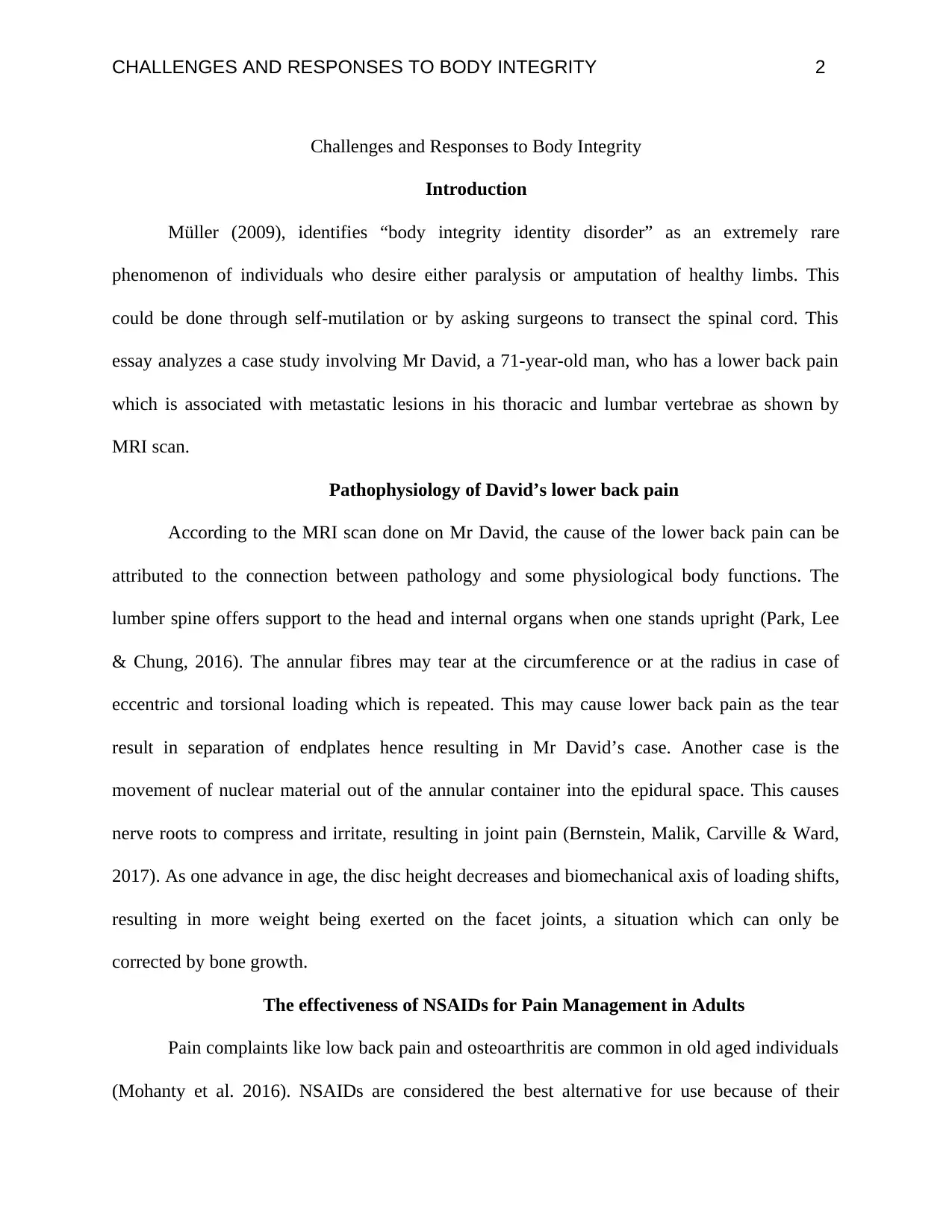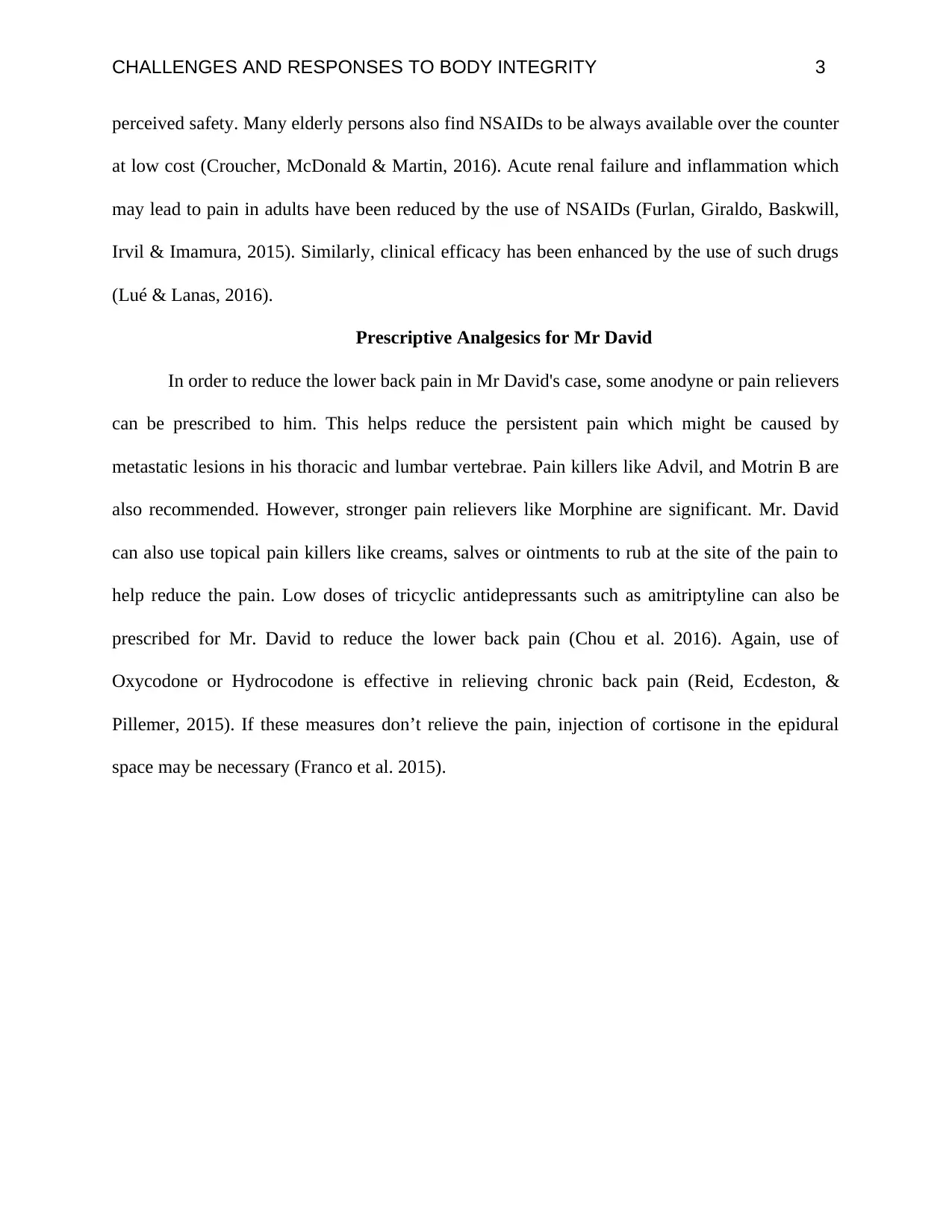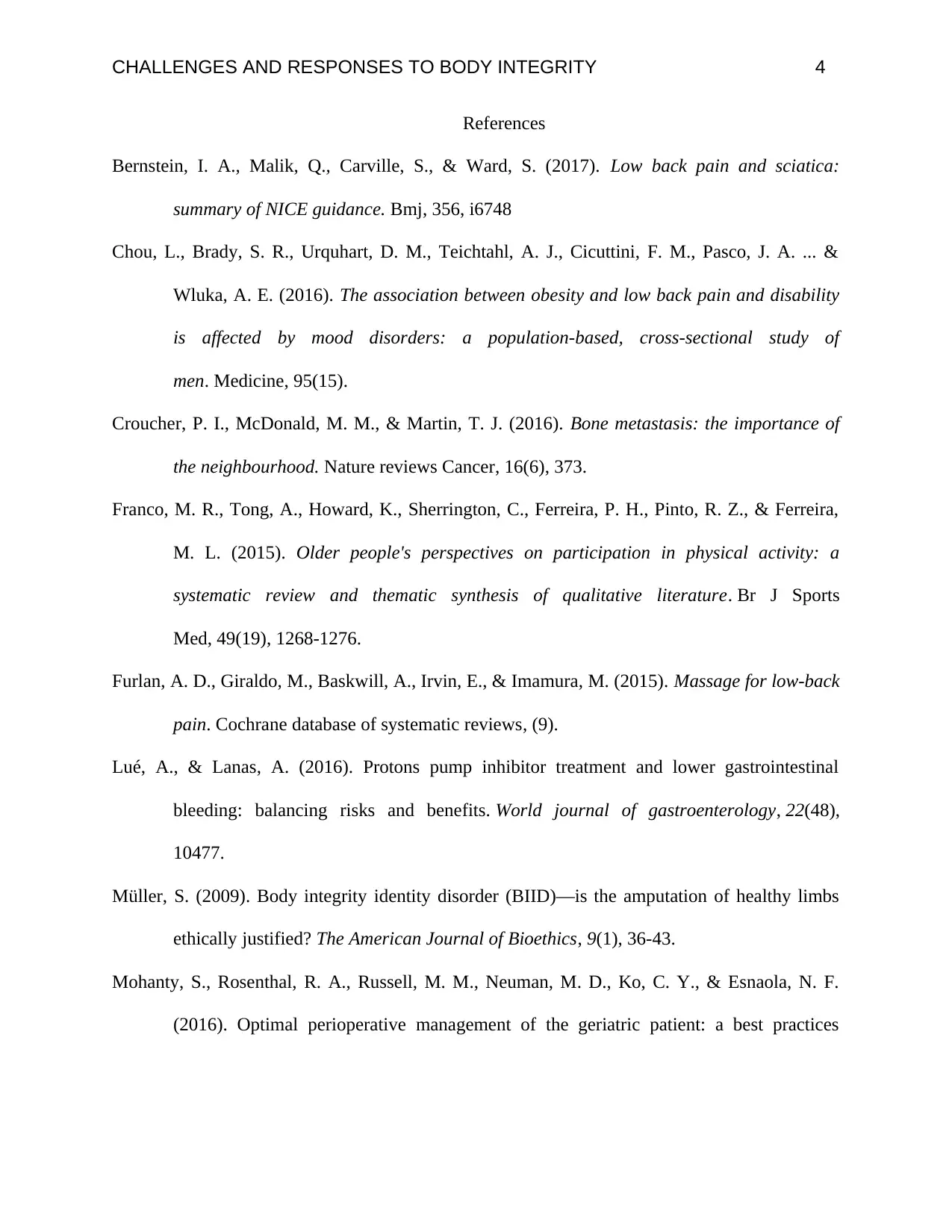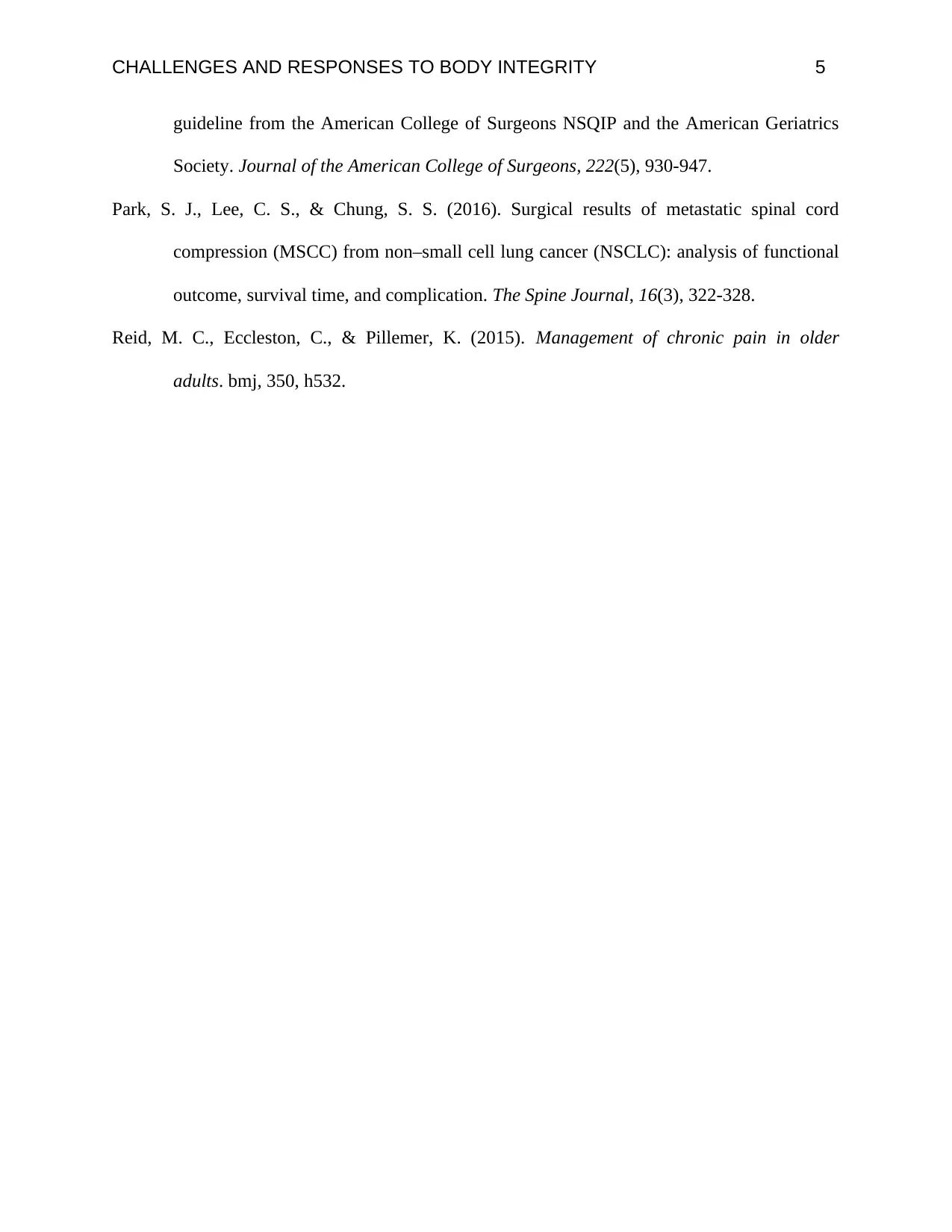NUR231 Case Study: Analyzing Challenges & Responses to Body Integrity
VerifiedAdded on 2023/04/25
|5
|1137
|417
Case Study
AI Summary
This case study analyzes the case of Mr. David, a 71-year-old man with lower back pain due to metastatic lesions, as identified through an MRI scan. It delves into the pathophysiology of his pain, linking it to the structural and functional changes in the lumbar spine, including annular fiber tears, nerve compression, and decreased disc height. The study discusses the effectiveness of NSAIDs for pain management in older adults, highlighting their accessibility and perceived safety, while also acknowledging potential risks. Furthermore, it explores prescriptive analgesics suitable for Mr. David, such as Advil, Motrin, and stronger options like Morphine, alongside topical treatments and low-dose tricyclic antidepressants. The analysis considers alternative treatments like cortisone injections if initial measures prove insufficient. Desklib provides access to similar case studies and resources for students seeking academic assistance.

Running head: CHALLENGES AND RESPONSE TO BODY INTEGRITY 1
Challenges and Response to Body Integrity
Student’s Name
Institutional Affiliation
Challenges and Response to Body Integrity
Student’s Name
Institutional Affiliation
Paraphrase This Document
Need a fresh take? Get an instant paraphrase of this document with our AI Paraphraser

CHALLENGES AND RESPONSES TO BODY INTEGRITY 2
Challenges and Responses to Body Integrity
Introduction
Müller (2009), identifies “body integrity identity disorder” as an extremely rare
phenomenon of individuals who desire either paralysis or amputation of healthy limbs. This
could be done through self-mutilation or by asking surgeons to transect the spinal cord. This
essay analyzes a case study involving Mr David, a 71-year-old man, who has a lower back pain
which is associated with metastatic lesions in his thoracic and lumbar vertebrae as shown by
MRI scan.
Pathophysiology of David’s lower back pain
According to the MRI scan done on Mr David, the cause of the lower back pain can be
attributed to the connection between pathology and some physiological body functions. The
lumber spine offers support to the head and internal organs when one stands upright (Park, Lee
& Chung, 2016). The annular fibres may tear at the circumference or at the radius in case of
eccentric and torsional loading which is repeated. This may cause lower back pain as the tear
result in separation of endplates hence resulting in Mr David’s case. Another case is the
movement of nuclear material out of the annular container into the epidural space. This causes
nerve roots to compress and irritate, resulting in joint pain (Bernstein, Malik, Carville & Ward,
2017). As one advance in age, the disc height decreases and biomechanical axis of loading shifts,
resulting in more weight being exerted on the facet joints, a situation which can only be
corrected by bone growth.
The effectiveness of NSAIDs for Pain Management in Adults
Pain complaints like low back pain and osteoarthritis are common in old aged individuals
(Mohanty et al. 2016). NSAIDs are considered the best alternative for use because of their
Challenges and Responses to Body Integrity
Introduction
Müller (2009), identifies “body integrity identity disorder” as an extremely rare
phenomenon of individuals who desire either paralysis or amputation of healthy limbs. This
could be done through self-mutilation or by asking surgeons to transect the spinal cord. This
essay analyzes a case study involving Mr David, a 71-year-old man, who has a lower back pain
which is associated with metastatic lesions in his thoracic and lumbar vertebrae as shown by
MRI scan.
Pathophysiology of David’s lower back pain
According to the MRI scan done on Mr David, the cause of the lower back pain can be
attributed to the connection between pathology and some physiological body functions. The
lumber spine offers support to the head and internal organs when one stands upright (Park, Lee
& Chung, 2016). The annular fibres may tear at the circumference or at the radius in case of
eccentric and torsional loading which is repeated. This may cause lower back pain as the tear
result in separation of endplates hence resulting in Mr David’s case. Another case is the
movement of nuclear material out of the annular container into the epidural space. This causes
nerve roots to compress and irritate, resulting in joint pain (Bernstein, Malik, Carville & Ward,
2017). As one advance in age, the disc height decreases and biomechanical axis of loading shifts,
resulting in more weight being exerted on the facet joints, a situation which can only be
corrected by bone growth.
The effectiveness of NSAIDs for Pain Management in Adults
Pain complaints like low back pain and osteoarthritis are common in old aged individuals
(Mohanty et al. 2016). NSAIDs are considered the best alternative for use because of their

CHALLENGES AND RESPONSES TO BODY INTEGRITY 3
perceived safety. Many elderly persons also find NSAIDs to be always available over the counter
at low cost (Croucher, McDonald & Martin, 2016). Acute renal failure and inflammation which
may lead to pain in adults have been reduced by the use of NSAIDs (Furlan, Giraldo, Baskwill,
Irvil & Imamura, 2015). Similarly, clinical efficacy has been enhanced by the use of such drugs
(Lué & Lanas, 2016).
Prescriptive Analgesics for Mr David
In order to reduce the lower back pain in Mr David's case, some anodyne or pain relievers
can be prescribed to him. This helps reduce the persistent pain which might be caused by
metastatic lesions in his thoracic and lumbar vertebrae. Pain killers like Advil, and Motrin B are
also recommended. However, stronger pain relievers like Morphine are significant. Mr. David
can also use topical pain killers like creams, salves or ointments to rub at the site of the pain to
help reduce the pain. Low doses of tricyclic antidepressants such as amitriptyline can also be
prescribed for Mr. David to reduce the lower back pain (Chou et al. 2016). Again, use of
Oxycodone or Hydrocodone is effective in relieving chronic back pain (Reid, Ecdeston, &
Pillemer, 2015). If these measures don’t relieve the pain, injection of cortisone in the epidural
space may be necessary (Franco et al. 2015).
perceived safety. Many elderly persons also find NSAIDs to be always available over the counter
at low cost (Croucher, McDonald & Martin, 2016). Acute renal failure and inflammation which
may lead to pain in adults have been reduced by the use of NSAIDs (Furlan, Giraldo, Baskwill,
Irvil & Imamura, 2015). Similarly, clinical efficacy has been enhanced by the use of such drugs
(Lué & Lanas, 2016).
Prescriptive Analgesics for Mr David
In order to reduce the lower back pain in Mr David's case, some anodyne or pain relievers
can be prescribed to him. This helps reduce the persistent pain which might be caused by
metastatic lesions in his thoracic and lumbar vertebrae. Pain killers like Advil, and Motrin B are
also recommended. However, stronger pain relievers like Morphine are significant. Mr. David
can also use topical pain killers like creams, salves or ointments to rub at the site of the pain to
help reduce the pain. Low doses of tricyclic antidepressants such as amitriptyline can also be
prescribed for Mr. David to reduce the lower back pain (Chou et al. 2016). Again, use of
Oxycodone or Hydrocodone is effective in relieving chronic back pain (Reid, Ecdeston, &
Pillemer, 2015). If these measures don’t relieve the pain, injection of cortisone in the epidural
space may be necessary (Franco et al. 2015).
⊘ This is a preview!⊘
Do you want full access?
Subscribe today to unlock all pages.

Trusted by 1+ million students worldwide

CHALLENGES AND RESPONSES TO BODY INTEGRITY 4
References
Bernstein, I. A., Malik, Q., Carville, S., & Ward, S. (2017). Low back pain and sciatica:
summary of NICE guidance. Bmj, 356, i6748
Chou, L., Brady, S. R., Urquhart, D. M., Teichtahl, A. J., Cicuttini, F. M., Pasco, J. A. ... &
Wluka, A. E. (2016). The association between obesity and low back pain and disability
is affected by mood disorders: a population-based, cross-sectional study of
men. Medicine, 95(15).
Croucher, P. I., McDonald, M. M., & Martin, T. J. (2016). Bone metastasis: the importance of
the neighbourhood. Nature reviews Cancer, 16(6), 373.
Franco, M. R., Tong, A., Howard, K., Sherrington, C., Ferreira, P. H., Pinto, R. Z., & Ferreira,
M. L. (2015). Older people's perspectives on participation in physical activity: a
systematic review and thematic synthesis of qualitative literature. Br J Sports
Med, 49(19), 1268-1276.
Furlan, A. D., Giraldo, M., Baskwill, A., Irvin, E., & Imamura, M. (2015). Massage for low‐back
pain. Cochrane database of systematic reviews, (9).
Lué, A., & Lanas, A. (2016). Protons pump inhibitor treatment and lower gastrointestinal
bleeding: balancing risks and benefits. World journal of gastroenterology, 22(48),
10477.
Müller, S. (2009). Body integrity identity disorder (BIID)—is the amputation of healthy limbs
ethically justified? The American Journal of Bioethics, 9(1), 36-43.
Mohanty, S., Rosenthal, R. A., Russell, M. M., Neuman, M. D., Ko, C. Y., & Esnaola, N. F.
(2016). Optimal perioperative management of the geriatric patient: a best practices
References
Bernstein, I. A., Malik, Q., Carville, S., & Ward, S. (2017). Low back pain and sciatica:
summary of NICE guidance. Bmj, 356, i6748
Chou, L., Brady, S. R., Urquhart, D. M., Teichtahl, A. J., Cicuttini, F. M., Pasco, J. A. ... &
Wluka, A. E. (2016). The association between obesity and low back pain and disability
is affected by mood disorders: a population-based, cross-sectional study of
men. Medicine, 95(15).
Croucher, P. I., McDonald, M. M., & Martin, T. J. (2016). Bone metastasis: the importance of
the neighbourhood. Nature reviews Cancer, 16(6), 373.
Franco, M. R., Tong, A., Howard, K., Sherrington, C., Ferreira, P. H., Pinto, R. Z., & Ferreira,
M. L. (2015). Older people's perspectives on participation in physical activity: a
systematic review and thematic synthesis of qualitative literature. Br J Sports
Med, 49(19), 1268-1276.
Furlan, A. D., Giraldo, M., Baskwill, A., Irvin, E., & Imamura, M. (2015). Massage for low‐back
pain. Cochrane database of systematic reviews, (9).
Lué, A., & Lanas, A. (2016). Protons pump inhibitor treatment and lower gastrointestinal
bleeding: balancing risks and benefits. World journal of gastroenterology, 22(48),
10477.
Müller, S. (2009). Body integrity identity disorder (BIID)—is the amputation of healthy limbs
ethically justified? The American Journal of Bioethics, 9(1), 36-43.
Mohanty, S., Rosenthal, R. A., Russell, M. M., Neuman, M. D., Ko, C. Y., & Esnaola, N. F.
(2016). Optimal perioperative management of the geriatric patient: a best practices
Paraphrase This Document
Need a fresh take? Get an instant paraphrase of this document with our AI Paraphraser

CHALLENGES AND RESPONSES TO BODY INTEGRITY 5
guideline from the American College of Surgeons NSQIP and the American Geriatrics
Society. Journal of the American College of Surgeons, 222(5), 930-947.
Park, S. J., Lee, C. S., & Chung, S. S. (2016). Surgical results of metastatic spinal cord
compression (MSCC) from non–small cell lung cancer (NSCLC): analysis of functional
outcome, survival time, and complication. The Spine Journal, 16(3), 322-328.
Reid, M. C., Eccleston, C., & Pillemer, K. (2015). Management of chronic pain in older
adults. bmj, 350, h532.
guideline from the American College of Surgeons NSQIP and the American Geriatrics
Society. Journal of the American College of Surgeons, 222(5), 930-947.
Park, S. J., Lee, C. S., & Chung, S. S. (2016). Surgical results of metastatic spinal cord
compression (MSCC) from non–small cell lung cancer (NSCLC): analysis of functional
outcome, survival time, and complication. The Spine Journal, 16(3), 322-328.
Reid, M. C., Eccleston, C., & Pillemer, K. (2015). Management of chronic pain in older
adults. bmj, 350, h532.
1 out of 5
Related Documents
Your All-in-One AI-Powered Toolkit for Academic Success.
+13062052269
info@desklib.com
Available 24*7 on WhatsApp / Email
![[object Object]](/_next/static/media/star-bottom.7253800d.svg)
Unlock your academic potential
Copyright © 2020–2025 A2Z Services. All Rights Reserved. Developed and managed by ZUCOL.





